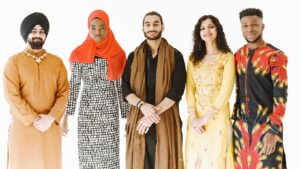In the vibrant world of fashion, cultural fusion stands as a testament to creativity and diversity. It’s a fascinating blend of traditions, colors, fabrics, and styles from around the globe, resulting in a unique aesthetic that transcends borders. This intriguing intersection of cultures is not just a trend, but a movement towards inclusivity and global unity in the fashion industry.
The allure of cultural fusion fashion lies in its ability to tell a story, to weave narratives of different cultures into a single piece of clothing. It’s about redefining style norms and celebrating the beauty of diversity. In the upcoming sections, we’ll delve deeper into this captivating world, exploring its origins, impact, and the designers who are making waves in this space.
Cultural Fusion Fashion

Cultural fusion fashion, a transformative domain, combines diverse customs, colors, fabrics, and styles from distinct cultures into unique aesthetics. It’s not simply a transient trend, it’s a progressive movement towards inclusivity and unity. It exemplifies a narrative-driven approach, weaving tales from various cultures into each fashion ensemble, pushing the boundaries of style norms, and lauding diversity. Understanding cultural fusion fashion requires delving into its origins, considering its worldwide impact, and scrutinizing key designers who champion this interpretative approach. The subsequent subsections offer an in-depth investigation into these dimensions, further highlighting the relevance and resonance of cultural fusion fashion in a globally interconnected society.
Impact of Cultural Fusion Fashion on the Industry

Cultural fusion fashion makes a definitive footprint in the fashion industry, triggering transformation on multiple fronts; designers, consumer preferences, and market trends bear its influence. Designers thrive on the culture-infused creativity, employing a mix of aesthetics, traditions, and stories as the bedrock for innovative designs. Key influencers, such as Ruchika Sachdeva, have blazed a trail with designs that blend Indian tradition and western silhouettes, shaking up industry norms.
Consumers gravitate towards this eclectic blend, seeing it as an avenue for self-expression while affirming their cultural roots. A surge in demand has seen major fashion houses like Gucci and Chanel integrating cultural elements in their seasonal collections. Notably in 2018, Gucci’s “Soul Scene” campaign incorporated African culture-inspired aesthetics, reflecting the market’s growing appetite for diversity.
Overall, from sparking innovation to enhancing inclusivity and sustainability, cultural fusion fashion leaves an indelible impact on the industry, shaping the future of fashion.
Iconic Examples of Cultural Fusion Fashion
Givenchy, for example, merges elements from Japanese Kimonos with European couture, producing cutting-edge designs that captivate fashionistas worldwide. Adding vibrancy to fashion, Sacai’s Chitose Abe adapts traditional motifs from diverse cultures, infusing them into contemporary clothes that echo globalization. Embracing cultural diversity, Stella Jean merges her Italian heritage with Haitian influences, resulting in an eclectic chic style appreciated globally.

As an homage to cultural fusion fashion, Kenzo’s pieces incorporate Asian aesthetics with European fashion sensibilities. Entertaining an audience of millions, Rihanna’s Fenty x Puma collection exhibits a fusion of American street fashion with influences from her Barbadian roots.
Reveling in cultural blend, high-street fashion brands like Zara and H&M launch collections inspired by an array of global traditions. Their designs, inspired by diverse cultures, achieve a harmonious aesthetic, exemplifying the essence of cultural fusion fashion.
Challenges in Cultural Fusion Fashion
Cultural fusion fashion isn’t just about merging styles—it’s a testament to the power of diversity. Designers like Sachdeva and brands from Givenchy to Zara are redefining the fashion landscape by blending traditions and challenging norms. They’re not just creating unique styles; they’re promoting unity and inclusivity. But it’s not without its challenges. Maintaining authenticity while incorporating diverse elements can be a delicate balance. Yet, the industry continues to evolve, influenced by this trend. It’s reshaping consumer preferences and market trends, fostering a more inclusive fashion world. So while cultural fusion fashion may present certain hurdles, its impact is undeniable. It’s a celebration of diversity, a testament to the power of unity, and a bold statement of inclusivity in fashion.

